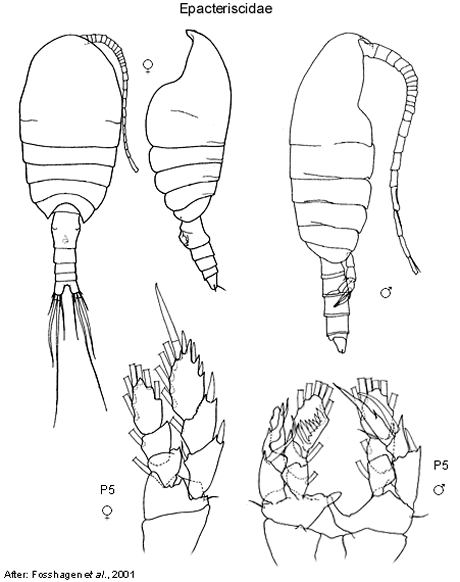 |
||||||
|
|
|
|
|
|
Calanoidea: FamiliesJ.M. Bradford-GrieveEpacteriscidae Fosshagen, 1973 Description. Female. Rostrum with 2 filaments; rostral margin extends into 2 points, or extends into 2 blunt protrusions, or not extended. Cephalosome and pedigerous somite 1 separate; pedigerous somites 4 and 5 separate. Posterior corners of prosome in lateral view bluntly rounded; dorsal view symmetrical. Urosome with 3 free somites, or with 4 free somites. Genital double-somite symmetrical in dorsal view; gonopores close together and totally covered by single genital operculum; with pair of seminal receptacles; with pair of copulatory pores that are completely covered by genital operculum. Caudal rami symmetrical. Mouthparts. Antenna 1 with 24-27 free segments; ancestral segments X and XI fused, or partly fused. Antenna 2 exopod with 4-8 free segments; 7-11 setae; with 3 terminal setae, or with 4 terminal setae; basis and endopod separate. Mandible basis with 1 seta, or with 4 setae; endopod 2-segmented, or 1-segmented, or absent; endopod terminal segment with 0 setae, or 1 setae, or 2 setae, or 3 setae, or 4 setae, or 8 setae. Maxilla 1 basal exite seta present, or absent; exopod extends short of endopod distal border. Maxilla 2 coxal epipodite seta absent; endopod setae normal, or claw-like. Maxilliped coxal endite 2 with 1 seta, or with 4 setae. Legs. Leg 1 basis inner distal seta inserted directly on surface of joint; outer seta absent; endopod with 3 segments; exopod with 3 segments; exopod segment 1 with outer distal spine; exopod segment 3 with 4 inner setae. Leg 2 endopod with 3 segments; exopod with 3 segments; exopod segment 3 with 2 outer spines. Leg 3 basis outer distal spine present, or absent; endopod segment 3 with 8 setae. Legs 3 and 4 endopod with 3 segments; exopod with 3 segments; exopod segment 3 with 2 outer spines, or 3 outer spines; exopod segment 3 with 5 inner setae. Leg 4 endopod segment 3 with 7 setae. Legs 2-4 surfaces naked; terminal spine with outer border smooth, or with outer border serrated. Leg 5 present; similar to legs 2-4; coxa inner border without seta; exopod segment 2 inner distal border with ordinary seta. Leg 5 exopod segment 3 outer border with 2 spines, or with 3 spines; inner border with 4 setae. Mode of life. Benthopelagic, in coastal waters or in anchialine caves. Distribution on sea floor. Less than 100 m. Generic composition. This family contains 12 genera: Balinella Fosshagen, Boxshall, Iliffe, 2001; Bofuriella Fosshagen, Boxshall, Iliffe, 2001; Bomburiella Fosshagen, Boxshall, Iliffe, 2001; Bunderia Jaume & Humphreys, 2001; Edaxiella Fosshagen, Boxshall, Iliffe, 2001; Enantiosis Barr, 1984; Enantrionia Fosshagen, Boxshall, Iliffe, 2001; Enantronoides Fosshagen, Boxshall, Iliffe, 2001; Erebonectes Fosshagen, 1985; Epacteriscus Fosshagen, 1973; Erebonectoides Fosshagen, Boxshall, Iliffe, 2001; Gloinella Fosshagen, Boxshall, Iliffe, 2001; Oinella Fosshagen, Boxshall, Iliffe, 2001.
(Variant) Male (sexually dimorphic characters). Description. Male. Mouthparts. Mouthparts well-developed. Antenna 1 geniculate on right; geniculation between ancestral segments XX and XXI. Maxilliped endopod segments 5 and 6 with outer setae normal. Legs. Right leg 5 biramous; endopod 3-segmented; exopod usually elongate, similar to female leg 5 or transformed, 3-segmented with segment 3 tending to be spine-like. Left leg 5 biramous; endopod 3-segmented; exopod usually elongate, similar to female leg 5 or highly transformed (most transformed in Enantiosis), usually 3-segmented (2-segmented in Epacteriscus).
Cite this publication as: 'Bradford-Grieve, J.M. (2002 onwards). Calanoida: families. Version 1: 2 October 2002. https://crustacea.net'. |
|
|
|
|
|
|
|
|
|
Copyright © Australian Museum, 2002 - 2003
Australian Museum website
